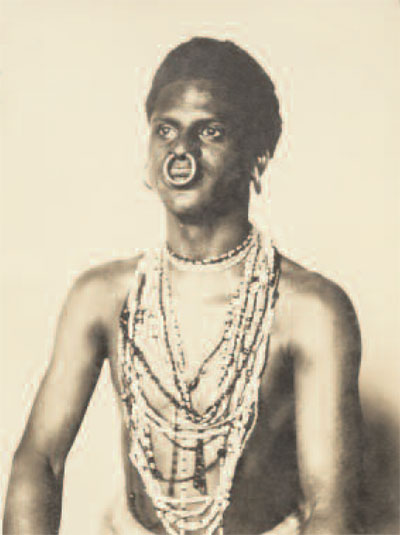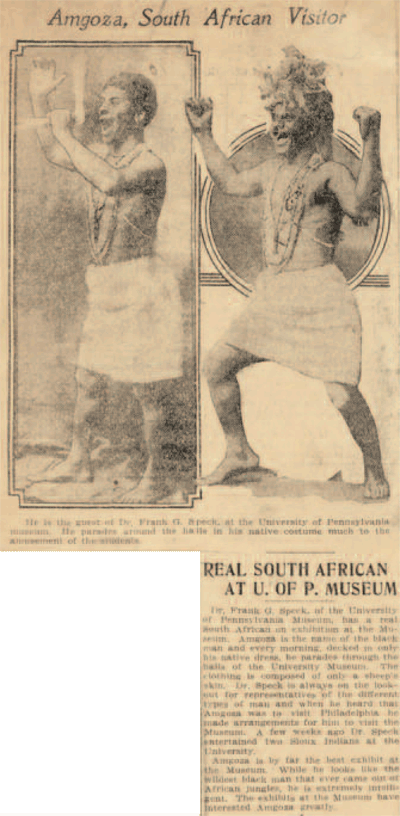
“Real South African at U. of P. Museum” Thus was a new “exhibit” at the Museum announced on January 28, 1911, in Press, a Philadelphia newspaper. On display was Bata Kindai Amgoza ibn LoBagola, seemingly a native of West Africa. Dressed only in a sheepskin skirt, with a large brass ring piercing his nose, LoBagola had been invited by Frank G. Speck,Assistant Curator of General Ethnology at the Museum (and later founder of Penn’s Anthropology Department), to perform dances and other rituals for Museum visitors. Although not an expert in African cultures, Speck had a strong interest in ethnology, or comparative cultural anthropology. Speck interviewed LoBagola at length and recorded him singing songs on wax cylinders, excerpts of which were transcribed and published in the Museum Journal (II (2):54). What attracted the attention of the public, however, was the sight of LoBagola dressed in a skirt, necklaces,and a headdress, parading through the Museum’s galleries. According to the newspaper, LoBagola was “by far the best exhibit at the Museum.”
But who was he? When Speck invited him to the Museum, LoBagola claimed to have been born in Dahomey (modern Benin in West Africa), a Black Jew descended from the Lost Tribes of Israel, who at a young age had been rescued at sea and taken to Scotland, where he attended boarding school and learned of “civilization.” After returning to his homeland, he made his way back to Europe many times and eventually to the United States. A popular entertainer, he performed and lectured to large audiences about his culture and customs.
In reality, however, LoBagola was Joseph Howard Lee, born in Baltimore, Maryland, in 1887. His creation of the persona of LoBagola was a daring and successful attempt to escape the life handed to him as a son of former slaves in a country where segregation and discrimination were rampant. By claiming an African opposed to African-American—origin he used his great talent for showmanship and manipulation to gain more appreciation and mobility in society and the world than was possible to most African-Americans at the time.

Although Frank Speck was not the only person he fooled, LoBagola did make a point of apologizing for misleading the Museum’s scholars in his 1929 autobiography, LoBagola: An African Savage’s Own Story (New York: A. A.Knopf):
These men asked me to give information about the social organization of the people of Dahomey…. I supplied them with what I knew of that country, but I was not certain whether what I said was accurate or not, because there is as much difference between a Dahomeyan and one of my people as there is between a flea and an elephant. At that time I was not asked questions about my own people. I took it for granted that I was t o talk about what the questioners wanted to know about. They did not know how to question me….I told them what I knew and added anything I could think of. I did not imagine that the men wished anything but entertainment….I suppose the good gentlemen of the University of Pennsylvania discussed me, and I am sure that it must have dawned on them that they were in error in the way they sought information. (pp. 332–33)
LoBagola never did acknowledge the full extent of his fraud—leaving it to others to identify him as Joseph Howard Lee from Baltimore. He admitted only to being an entertainer.
